Bangbang Yang
ImmerseGen: Agent-Guided Immersive World Generation with Alpha-Textured Proxies
Jun 18, 2025Abstract:Automatic creation of 3D scenes for immersive VR presence has been a significant research focus for decades. However, existing methods often rely on either high-poly mesh modeling with post-hoc simplification or massive 3D Gaussians, resulting in a complex pipeline or limited visual realism. In this paper, we demonstrate that such exhaustive modeling is unnecessary for achieving compelling immersive experience. We introduce ImmerseGen, a novel agent-guided framework for compact and photorealistic world modeling. ImmerseGen represents scenes as hierarchical compositions of lightweight geometric proxies, i.e., simplified terrain and billboard meshes, and generates photorealistic appearance by synthesizing RGBA textures onto these proxies. Specifically, we propose terrain-conditioned texturing for user-centric base world synthesis, and RGBA asset texturing for midground and foreground scenery. This reformulation offers several advantages: (i) it simplifies modeling by enabling agents to guide generative models in producing coherent textures that integrate seamlessly with the scene; (ii) it bypasses complex geometry creation and decimation by directly synthesizing photorealistic textures on proxies, preserving visual quality without degradation; (iii) it enables compact representations suitable for real-time rendering on mobile VR headsets. To automate scene creation from text prompts, we introduce VLM-based modeling agents enhanced with semantic grid-based analysis for improved spatial reasoning and accurate asset placement. ImmerseGen further enriches scenes with dynamic effects and ambient audio to support multisensory immersion. Experiments on scene generation and live VR showcases demonstrate that ImmerseGen achieves superior photorealism, spatial coherence and rendering efficiency compared to prior methods. Project webpage: https://immersegen.github.io.
HiScene: Creating Hierarchical 3D Scenes with Isometric View Generation
Apr 17, 2025Abstract:Scene-level 3D generation represents a critical frontier in multimedia and computer graphics, yet existing approaches either suffer from limited object categories or lack editing flexibility for interactive applications. In this paper, we present HiScene, a novel hierarchical framework that bridges the gap between 2D image generation and 3D object generation and delivers high-fidelity scenes with compositional identities and aesthetic scene content. Our key insight is treating scenes as hierarchical "objects" under isometric views, where a room functions as a complex object that can be further decomposed into manipulatable items. This hierarchical approach enables us to generate 3D content that aligns with 2D representations while maintaining compositional structure. To ensure completeness and spatial alignment of each decomposed instance, we develop a video-diffusion-based amodal completion technique that effectively handles occlusions and shadows between objects, and introduce shape prior injection to ensure spatial coherence within the scene. Experimental results demonstrate that our method produces more natural object arrangements and complete object instances suitable for interactive applications, while maintaining physical plausibility and alignment with user inputs.
DiffSplat: Repurposing Image Diffusion Models for Scalable Gaussian Splat Generation
Jan 28, 2025Abstract:Recent advancements in 3D content generation from text or a single image struggle with limited high-quality 3D datasets and inconsistency from 2D multi-view generation. We introduce DiffSplat, a novel 3D generative framework that natively generates 3D Gaussian splats by taming large-scale text-to-image diffusion models. It differs from previous 3D generative models by effectively utilizing web-scale 2D priors while maintaining 3D consistency in a unified model. To bootstrap the training, a lightweight reconstruction model is proposed to instantly produce multi-view Gaussian splat grids for scalable dataset curation. In conjunction with the regular diffusion loss on these grids, a 3D rendering loss is introduced to facilitate 3D coherence across arbitrary views. The compatibility with image diffusion models enables seamless adaptions of numerous techniques for image generation to the 3D realm. Extensive experiments reveal the superiority of DiffSplat in text- and image-conditioned generation tasks and downstream applications. Thorough ablation studies validate the efficacy of each critical design choice and provide insights into the underlying mechanism.
TexPro: Text-guided PBR Texturing with Procedural Material Modeling
Oct 21, 2024
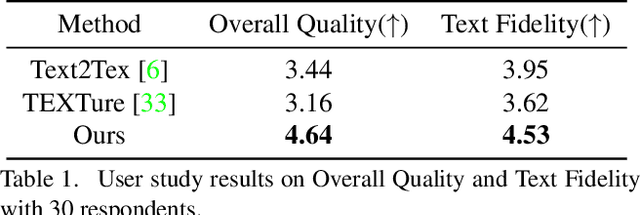
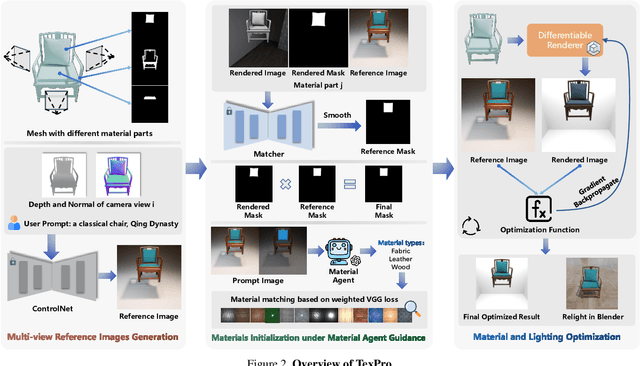
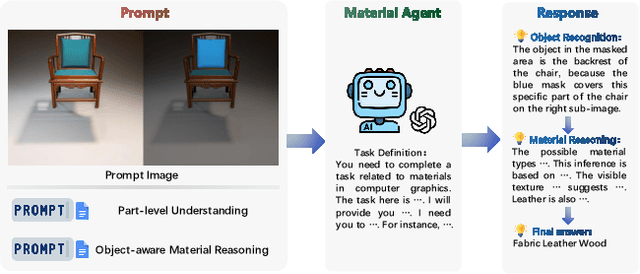
Abstract:In this paper, we present TexPro, a novel method for high-fidelity material generation for input 3D meshes given text prompts. Unlike existing text-conditioned texture generation methods that typically generate RGB textures with baked lighting, TexPro is able to produce diverse texture maps via procedural material modeling, which enables physical-based rendering, relighting, and additional benefits inherent to procedural materials. Specifically, we first generate multi-view reference images given the input textual prompt by employing the latest text-to-image model. We then derive texture maps through a rendering-based optimization with recent differentiable procedural materials. To this end, we design several techniques to handle the misalignment between the generated multi-view images and 3D meshes, and introduce a novel material agent that enhances material classification and matching by exploring both part-level understanding and object-aware material reasoning. Experiments demonstrate the superiority of the proposed method over existing SOTAs and its capability of relighting.
4K4DGen: Panoramic 4D Generation at 4K Resolution
Jun 19, 2024
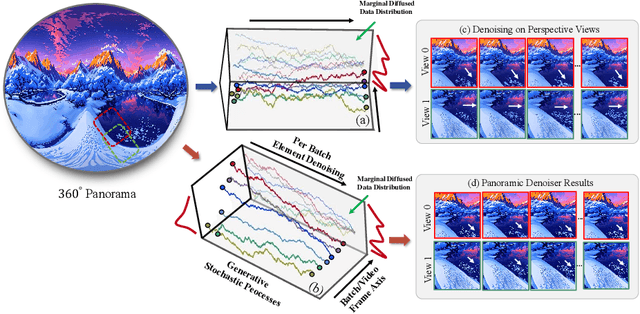

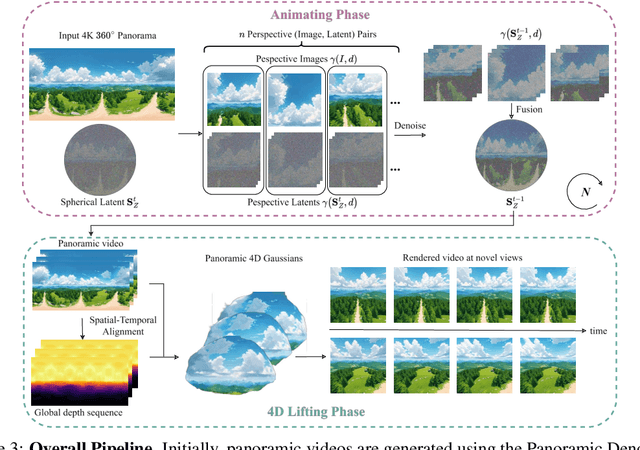
Abstract:The blooming of virtual reality and augmented reality (VR/AR) technologies has driven an increasing demand for the creation of high-quality, immersive, and dynamic environments. However, existing generative techniques either focus solely on dynamic objects or perform outpainting from a single perspective image, failing to meet the needs of VR/AR applications. In this work, we tackle the challenging task of elevating a single panorama to an immersive 4D experience. For the first time, we demonstrate the capability to generate omnidirectional dynamic scenes with 360-degree views at 4K resolution, thereby providing an immersive user experience. Our method introduces a pipeline that facilitates natural scene animations and optimizes a set of 4D Gaussians using efficient splatting techniques for real-time exploration. To overcome the lack of scene-scale annotated 4D data and models, especially in panoramic formats, we propose a novel Panoramic Denoiser that adapts generic 2D diffusion priors to animate consistently in 360-degree images, transforming them into panoramic videos with dynamic scenes at targeted regions. Subsequently, we elevate the panoramic video into a 4D immersive environment while preserving spatial and temporal consistency. By transferring prior knowledge from 2D models in the perspective domain to the panoramic domain and the 4D lifting with spatial appearance and geometry regularization, we achieve high-quality Panorama-to-4D generation at a resolution of (4096 $\times$ 2048) for the first time. See the project website at https://4k4dgen.github.io.
Coin3D: Controllable and Interactive 3D Assets Generation with Proxy-Guided Conditioning
May 13, 2024Abstract:As humans, we aspire to create media content that is both freely willed and readily controlled. Thanks to the prominent development of generative techniques, we now can easily utilize 2D diffusion methods to synthesize images controlled by raw sketch or designated human poses, and even progressively edit/regenerate local regions with masked inpainting. However, similar workflows in 3D modeling tasks are still unavailable due to the lack of controllability and efficiency in 3D generation. In this paper, we present a novel controllable and interactive 3D assets modeling framework, named Coin3D. Coin3D allows users to control the 3D generation using a coarse geometry proxy assembled from basic shapes, and introduces an interactive generation workflow to support seamless local part editing while delivering responsive 3D object previewing within a few seconds. To this end, we develop several techniques, including the 3D adapter that applies volumetric coarse shape control to the diffusion model, proxy-bounded editing strategy for precise part editing, progressive volume cache to support responsive preview, and volume-SDS to ensure consistent mesh reconstruction. Extensive experiments of interactive generation and editing on diverse shape proxies demonstrate that our method achieves superior controllability and flexibility in the 3D assets generation task.
GeneAvatar: Generic Expression-Aware Volumetric Head Avatar Editing from a Single Image
Apr 02, 2024



Abstract:Recently, we have witnessed the explosive growth of various volumetric representations in modeling animatable head avatars. However, due to the diversity of frameworks, there is no practical method to support high-level applications like 3D head avatar editing across different representations. In this paper, we propose a generic avatar editing approach that can be universally applied to various 3DMM driving volumetric head avatars. To achieve this goal, we design a novel expression-aware modification generative model, which enables lift 2D editing from a single image to a consistent 3D modification field. To ensure the effectiveness of the generative modification process, we develop several techniques, including an expression-dependent modification distillation scheme to draw knowledge from the large-scale head avatar model and 2D facial texture editing tools, implicit latent space guidance to enhance model convergence, and a segmentation-based loss reweight strategy for fine-grained texture inversion. Extensive experiments demonstrate that our method delivers high-quality and consistent results across multiple expression and viewpoints. Project page: https://zju3dv.github.io/geneavatar/
DreamSpace: Dreaming Your Room Space with Text-Driven Panoramic Texture Propagation
Oct 19, 2023



Abstract:Diffusion-based methods have achieved prominent success in generating 2D media. However, accomplishing similar proficiencies for scene-level mesh texturing in 3D spatial applications, e.g., XR/VR, remains constrained, primarily due to the intricate nature of 3D geometry and the necessity for immersive free-viewpoint rendering. In this paper, we propose a novel indoor scene texturing framework, which delivers text-driven texture generation with enchanting details and authentic spatial coherence. The key insight is to first imagine a stylized 360{\deg} panoramic texture from the central viewpoint of the scene, and then propagate it to the rest areas with inpainting and imitating techniques. To ensure meaningful and aligned textures to the scene, we develop a novel coarse-to-fine panoramic texture generation approach with dual texture alignment, which both considers the geometry and texture cues of the captured scenes. To survive from cluttered geometries during texture propagation, we design a separated strategy, which conducts texture inpainting in confidential regions and then learns an implicit imitating network to synthesize textures in occluded and tiny structural areas. Extensive experiments and the immersive VR application on real-world indoor scenes demonstrate the high quality of the generated textures and the engaging experience on VR headsets. Project webpage: https://ybbbbt.com/publication/dreamspace
Graph-based Asynchronous Event Processing for Rapid Object Recognition
Aug 28, 2023



Abstract:Different from traditional video cameras, event cameras capture asynchronous events stream in which each event encodes pixel location, trigger time, and the polarity of the brightness changes. In this paper, we introduce a novel graph-based framework for event cameras, namely SlideGCN. Unlike some recent graph-based methods that use groups of events as input, our approach can efficiently process data event-by-event, unlock the low latency nature of events data while still maintaining the graph's structure internally. For fast graph construction, we develop a radius search algorithm, which better exploits the partial regular structure of event cloud against k-d tree based generic methods. Experiments show that our method reduces the computational complexity up to 100 times with respect to current graph-based methods while keeping state-of-the-art performance on object recognition. Moreover, we verify the superiority of event-wise processing with our method. When the state becomes stable, we can give a prediction with high confidence, thus making an early recognition. Project page: \url{https://zju3dv.github.io/slide_gcn/}.
Tri-MipRF: Tri-Mip Representation for Efficient Anti-Aliasing Neural Radiance Fields
Jul 21, 2023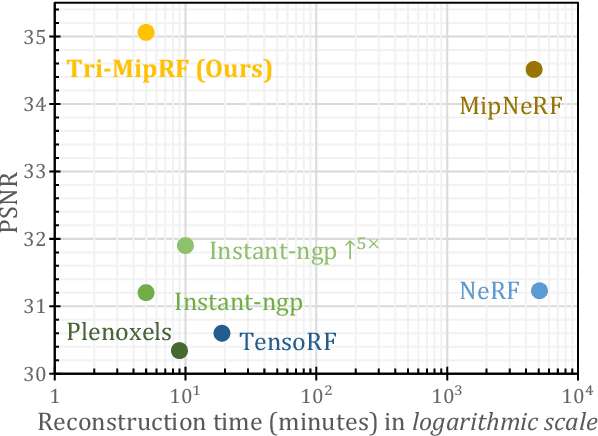


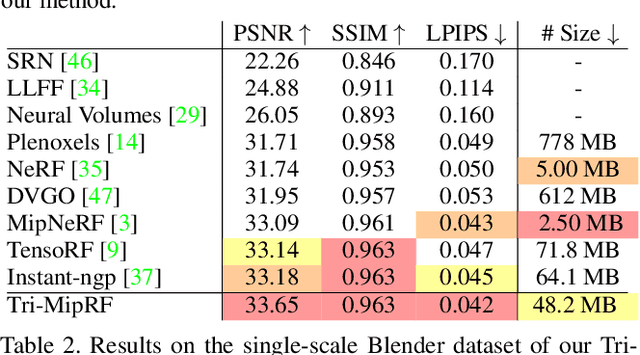
Abstract:Despite the tremendous progress in neural radiance fields (NeRF), we still face a dilemma of the trade-off between quality and efficiency, e.g., MipNeRF presents fine-detailed and anti-aliased renderings but takes days for training, while Instant-ngp can accomplish the reconstruction in a few minutes but suffers from blurring or aliasing when rendering at various distances or resolutions due to ignoring the sampling area. To this end, we propose a novel Tri-Mip encoding that enables both instant reconstruction and anti-aliased high-fidelity rendering for neural radiance fields. The key is to factorize the pre-filtered 3D feature spaces in three orthogonal mipmaps. In this way, we can efficiently perform 3D area sampling by taking advantage of 2D pre-filtered feature maps, which significantly elevates the rendering quality without sacrificing efficiency. To cope with the novel Tri-Mip representation, we propose a cone-casting rendering technique to efficiently sample anti-aliased 3D features with the Tri-Mip encoding considering both pixel imaging and observing distance. Extensive experiments on both synthetic and real-world datasets demonstrate our method achieves state-of-the-art rendering quality and reconstruction speed while maintaining a compact representation that reduces 25% model size compared against Instant-ngp.
* Accepted to ICCV 2023 Project page: https://wbhu.github.io/projects/Tri-MipRF
 Add to Chrome
Add to Chrome Add to Firefox
Add to Firefox Add to Edge
Add to Edge